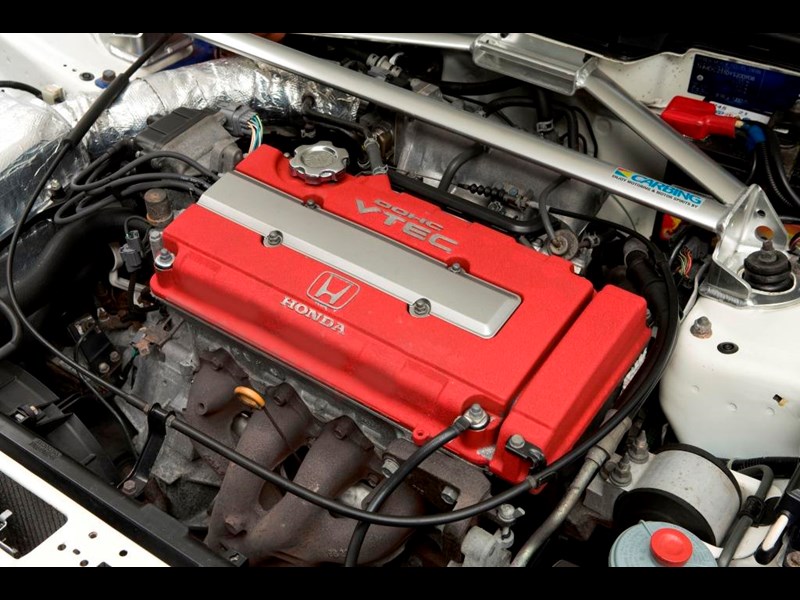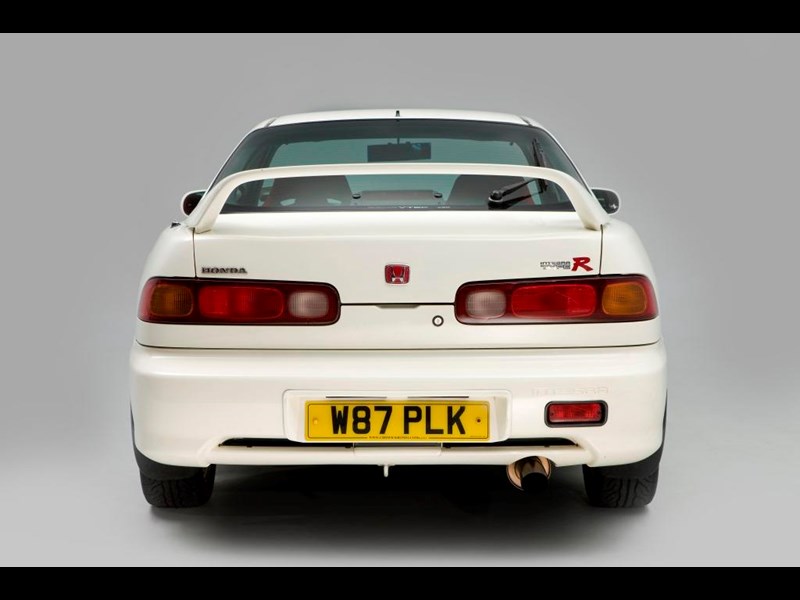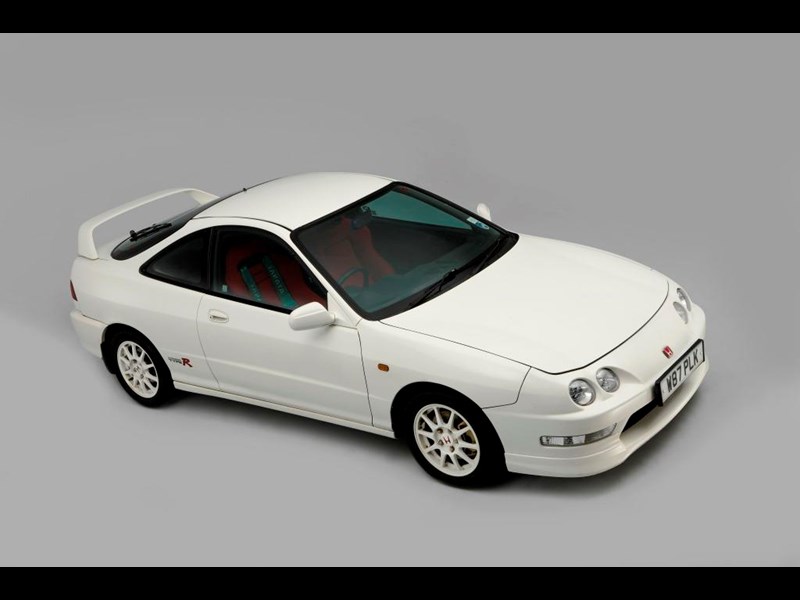The R stands for Racing, so from the outset Honda’s intentions were clear with its Integra Type R. But nobody expected this unassuming coupé to be this good...
It would now be hard to imagine Honda without its Type R division, but until the Integra Type R of 1997 we’d never heard of the Japanese marque’s sporting offshoot. The Japanese market had been able to enjoy a track-ready Integra for a full two years already and in 1992 there had been an NSX Type R for the home market, but for UK buyers this was their first chance to dip into the Type R brand.
It was worth the wait though, as the hotted-up coupé is regarded by many as the best front-wheel drive sportscar ever made. Yes – it really is that good to drive. When Russell Bulgin reviewed it for Car magazine he described how its ‘race car throttle sensitivity and rev lunacy’ combined with ‘fetishistic levels of steering and precision braking.’ He concluded the Type R was ‘as extreme a car as you can buy.’
It’s easy to see why the Integra is so highly regarded, because in typical Honda fashion there were no half measures. The bodyshell was strengthened with extra spot welds and strategically-placed thicker metal, but to offset any weight gain there was a thinner windscreen, lighter wheels plus less soundproofing. Naturally the 1.8-litre engine was also beefed up with high-compression pistons, polished intake ports and a revised VTEC system. The result was 187bhp, 131lb ft of torque and a red line set at a crazy 8700rpm.
Tipping the scales at just 1140kg the Integra Type R, internally codenamed DC2, could despatch the 0-60mph sprint in just 6.2 seconds before topping out at 145mph. But to focus on the stats is to do the Integra a major dis-service; it’s the way the car steers, handles, brakes and rides that makes it such a thriller. One of those rare cars that’s as much at home on the track as the public road, the Honda is good enough to make you revise your opinions if you’re a die-hard rear-wheel drive enthusiast – it really is that good.
VITAL STATISTICS
Engine 1797cc/4-cyl/DOHC
Power 187bhp@8000rpm
Torque 131lb ft@7300rpm
Maximum speed 137mph
0-60mph 6.2sec
Fuel consumption 28-35mpg
Transmission FWD, 5-speed man
WHAT TO LOOK FOR
SHELL SCRUTINY
All UK-market Integra Type Rs initially came in Championship White, although red and black followed in 1999. Many of the cars here weren’t originally sold in the UK; official cars have four circular headlamps while grey imports have rectangular lights, although conversions from UK to JDM (Japanese Domestic Market) are common. If buying an import check the service history, make sure the car is road legal in the UK and that it’s been properly undersealed. Corrosion is a big problem with UK cars; JDM Integras are undersealed, but not as extensively as UK examples. Whatever you’re buying check the rear wheelarches for rust, along with the spare wheel well and the boot, as water gets past the rear light seals.
Thanks to low values, many Integras have passed through the hands of owners with more driving enthusiasm than skill, so scrutinise all panel gaps which should be tight and even. Also check the boot floor and front inner wings for rippling; if you spot any, find another car. JDM cars are more likely to have been crashed than UK editions, and it’s impossible to ascertain their history.
ENGINE EXAM
Despite the stratospheric redline and high specific power output, the B18C twin-cam engine is incredibly reliable if looked after. That means oil changes every 6000 miles using a fully synthetic lubricant, and a fresh cambelt plus new spark plugs every five years or 60,000 miles. The coolant and fuel filters should also have been replaced within the last four years or 48,000 miles. Check that the official Honda air filter is still fitted; aftermarket ones tend to strangle the engine at high revs.
If there are rattles from underneath as the car is driven, the chances are it’s nothing more serious than a loose heatshield on the exhaust; it can be tightened up in minutes. Knocks as the engine is revved is probably because it’s making contact with the bodywork because of a failed rear engine mount, but it’s easily replaced.
TRANSMISSION TEST
The transmission is strong but it’ll take only so much abuse. All Type Rs came with a five-speed manual gearbox, a limited-slip diff and a hydraulic clutch; the slave cylinder for the latter is prone to leaks. A grinding noise when you dip the clutch suggests the release bearing has had it but the gearbox bearings could be tired; a gearbox rebuild costs £300-£500. Also check for crunching gear changes at high revs which means the synchromesh has had it.
KEEP US IN SUSPENSE
Few people buy one of these cars to potter about in, so the brakes and suspension have a hard time. While there are no inherent weaknesses, the suspension bushes (especially in the trailing arms) are likely to be tired so home in on them first – polyurethane replacements are available. Also, while the brakes are perfectly adequate even for fast road use, excursions onto the track will probably lead to them wearing out so feel for juddering under braking, betraying warped discs. Everything is available and there are plenty of upgrades available, and unless you get carried away parts costs are eminently reasonable. Also take a look at the gaiters on the steering rack; these split which is an automatic MoT failure – and splits won’t do the rack much good either.
ELECTRICKERY
As long as the electrical system hasn’t been butchered it should be reliable, largely because the Integra isn’t crammed with luxury equipment. It does have an electric aerial though, which can fail because of water getting into the mechanism causing it to seize. If the aerial is then activated there’s a good chance a fuse will blow, so if it won’t go up or down at all, that’s probably why. Also make sure that the red ignition key is available with the regular key. If you lose the regular ignition key and you don’t have this red alternative, you’ll have to stump up for a replacement from a Honda dealer and they’re expensive.
OUR VERDICT
You’ve got to have the driving experience high on your list of priorities to understand the Integra’s appeal, but if you want to savour every drive this is the car for you. Throw in incredible reliability plus a decent level of practicality and you’ll see this is no one-trick pony. Just don’t let anybody tell you the Honda isn’t a classic.




